In the Early Triassic period, about 248 million years ago, the Hupehsuchus, an ancient tiny marine reptile, filter-fed its way through the early oceans.
Paleontologists made the discovery after uncovering two intact Hupehsuchus nanchangensis skull specimens in a recent study published in BMC Ecology and Evolution. The find makes it the first marine filter-feeder that appeared after Earth’s biggest mass extinction.
An Ancient Marine Reptile
The Hupehsuchus is a type of ichthyosauromorph with paddle-like limbs, and a duck-like snout. Most specimens of the reptile were found in the Hubei Province in China. The early marine reptiles appeared on the fossil record about three million years after the Permian-Triassic extinction event.
Considered the Earth’s biggest mass extinction in “The Great Dying,” about 96 percent of the planet’s marine species died when a global warming period caused a mass oxygen loss in the world’s oceans. About 80 percent of oxygen left in the ocean was lost, leaving the deepest depths completely oxygen-free.
The Hupehsuchus was a marine reptile that emerged after the apocalyptic event and was part of the ocean’s re-population.
Read More: The Permian Extinction: Life on Earth Nearly Disappeared During the ‘Great Dying’
Evolving Feeding Strategies
Unlike modern whales that span up to 108 feet long in our oceans today, the Hupehsuchus was only 3 feet long. And while the Hupehsuchus had filter-feeding-like abilities, they were unrelated to modern-day whales.
Even more surprising was scientists found that while it took modern whales 30 million years to evolve filter-feeding adaptations, filter-feeding was achieved by Hupehsuchus in the Early Triassic in less than five million years.
“We were amazed to discover these adaptations in such an early marine reptile,” said Zi-Chen Fang, a paleontologist at the Wuhan Center of China Geological Survey and study lead author, in a statement. “The hupehsuchians were a unique group in China, close relatives of the ichthyosaurs, and known for 50 years, but their mode of life was not fully understood.”
When comparing the skulls of the ancient reptile with modern whales, the team found that they had similar-looking structures in their mouths. The fossils were more complete than other earlier finds and revealed that the reptile’s long snout had unfused, strap-like bones with a long space between them that ran the length of the nose.
Its structure is like modern baleen whales, where the loose structure of the snout and lower jaws support a throat region that balloons out as they swim forward. The technique allows the whales to engulf small prey, explained Long Cheng, a paleontologist at the Wuhan Center of China Geological Survey and study author, in a press release.
New Fossils Reveal Filter-Feeders
The feeding strategies of the Hupehsuchus were unknown because previous skulls were poorly preserved. Some experts had suspected this reptile was a filter-feeder, but the idea was rejected because it had a narrow skull and small neck. Others argued that it could still filter-feed like pelicans or rorquals do.
To settle the arguments, the team took a closer look at other Hupehsuchus specimens and compared them to the skulls of 130 modern animals, including 15 different species of baleen whales, 23 seal species, 14 crocodilians, 52 toothed whale species, 25 bird species and the platypus.
The new fossils revealed that the Hupehsuchus had prominent chubby cheeks or an enlarged buccal cavity to enable filter feeding. They may have used soft baleen tissues to shoot out the filtered water from its oral cavity. Its large trunk (possibly vestigial from terrestrial ancestors) with crocodile-like plated ridges suggests it made its way through the oceans slowly and steadily.
Its environment in the Early Triassic consisted of a restrictive lagoon with low productivity in the early stages after an extinction event, which drove the Hupehsuchus to feed on zooplankton.
“Baleen whales have grooves along the jaws to support curtains of baleen, long thin strips of keratin, the protein that makes hair, feathers, and fingernails. Hupehsuchus had just the same grooves and notches along the edges of its jaws, and we suggest it had independently evolved into some form of baleen,” said Li Tian, study author, and paleontologist at the University of Geosciences Wuhan.
Read More: Scientists Film a Feeding Frenzy of 150 Fin Whales














